A Year In Burgundy II: Côte de Beaune’s Wines From The Incomparable 2015 Realize Their Potential, And Articulately Express The Distinctive Characters Of The Region’s Diverse Terroirs
In our last newsletter, we looked at Burgundy’s fantastic 2015 vintage as represented by some of the top vignerons in the Côte de Nuit. This week, we head south to Beaune to look at the stylistically-unique red wines of Nuit’s sister region. Beaune. You might expect that, being further south, the red wines of Beaune have a slightly better opportunity to ripen and become plush and rounded, and to some extent that is true: In general, Beaune’s climate is warmer than Nuit’s, and the rainfall is a little higher, allowing the grapes to better weather the late summer heat.
Whereas the top reds from the Côte de Nuits often have greater intensity and a firmer structure, top Côte de Beaune reds are frequently softer and lusher with soaring, earthy flavors laced with minerals and exotic spices. With age, they tend to cling to their fruit longer as tertiary flavors of coffee, hazelnut and forest bracken gradually take center stage.
Some of the domains presented here also have vineyards in Nuit, so if the names are familiar, it’s because these winemakers are border-hoppers whose wines are able to embody the best of the perfumed north and the silken fruit of the south.
2015 Burgundy: Hedonist’s Vintage
No one could better sum up Burgundy 2015 more splendidly than Jacques Devauges of Clos de Tart: “To make bad wine in 2015, one must wake up and say to yourself, ‘I will make bad wine.’”
This is not to say that it was an easy vintage—just a successful one. In fact—if the pun may be forgiven—the challenges ran hot and cold. Frost affected many Grand Cru vineyards early in the season and proved to be a harbinger of wet and cool temperatures in May. In mid-June, the weather became balmy, then hot, then seriously dry. According to Eric Remy at Domaine Leflaive, “Between June to August, we had 35 days when the temperature was above 30 degrees C and 15 days when the temperature was above 35 degrees C.”
The grapes were under hydric stress for most of that time; August brought off and on downpours, effectively saving the vintage, although the harvest window was narrow because potential alcohol levels were creeping up while acidity was dropping. White wine producers harvested end of August and nearly all the red wine producers harvested in the first week of September.
In all, there were many decisions a grower could have made in 2015 because there was so much material to work with. Some of the reds are elegant and ethereal—purposefully made so with light maceration and gentle handling. Others are dense, chewy and full-bodied, reminiscent of wine from warmer climates. Cécile Tremblay of the eponymous Vosne-Romanée domain says, “2015 had the best ripeness at harvest since I started winemaking. There was big quantity of polyphenols and too much of everything – I kept thinking of what to do with it. The big question was: Who am I making this wine for and what is the wine’s drinking window?”
In all, 2015—especially for red wines—has been heralded as having ‘nearly the concentration of 2005 allied with the sensuality of 2010.’
Ten Years After
That the finest Burgundies improve over time is no revelation. What is particularly interesting is that, unlike many age-worthy wines, Burgundy follows a somewhat unique path. There is no ‘peak’, for example—you make that discovery over the years as you sample a specific vintage from given label. There is a sort of ‘sine’ wave with multiple peaks and valleys. If a wine is unfriendly today, don’t assume it has passed its pinnacle—just push it further back in the cellar, and you’ll likely be rewarded.
For every rule in Burgundy, there are countless exceptions, but an experienced cellar master will tell you that after a few years in the bottle (generally between five and eight), when the fruit begins to fade a bit, there is a period when the wine may taste thin and a bit shrill. You might revive the old optimistic tombstone inscription: ‘Not dead, but sleeping.’
If the original wine was from a good vintage and was produced with circumspection, it will reanimate with tertiary notes—the fruit dries out to evoke raisin, fig or prune and more savory and musky aromas emerge as well, evocative of licorice, leather, mushroom, tobacco and dried bracken on a forest floor.
The wines in this collection have just entered this phase where the springtime purple notes have grown into the russet tones of autumn; along with us all, the refreshing, youthful smells of blackberry and cherry cola have matured into the introspective richness of adulthood.
Côte de Beaune
Here is a mnemonic device for remembering which shade of wine is best represented by the two subdivisions of the Côte d’Or, the Côte de Beaune and the Côte de Nuit: Bones are white, and the greatest of the Chardonnay-based white Burgundy (Corton-Charlemagne, Montrachet, et al) are from Beaune. Night is dark, and the greatest Pinot Noir-based reds (La Romanée-Conti, Chambertin, et al) come from the ‘Night Slopes’—the Côte de Nuit.
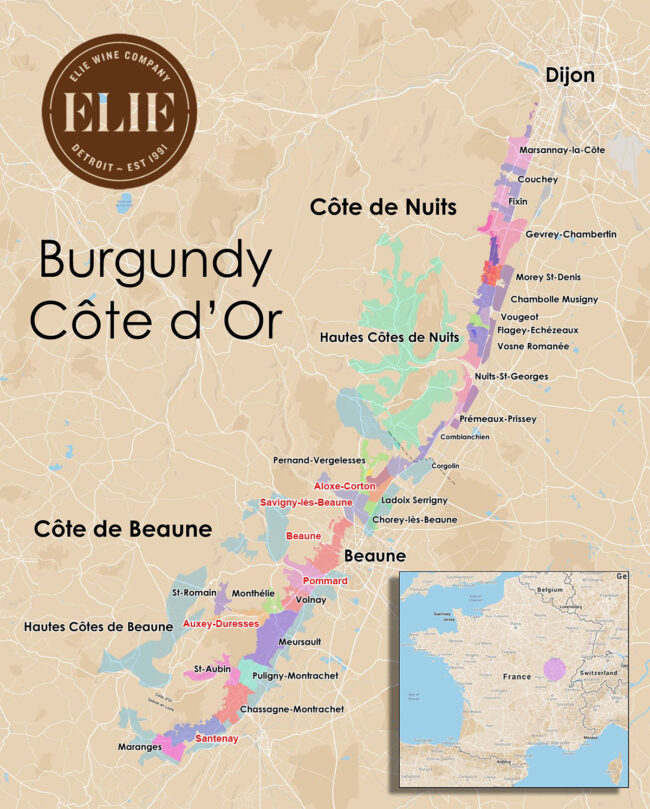
Of course, both regions make wines of either color. The Côte de Beaune is the southern half of the Côte d’Or escarpment, hilly country where, like the bowls of porridge in Goldilocks, the topsoils near the tops of the elevation are too sparse to support vines and, in the valleys, too fertile to produce top quality wine. The Goldilocks Zone (the mid-slopes) are where the Grand and Premier Cru vineyards are found, primarily at elevations between 720 and 980 feet. Drainage is good, and when vines are properly located to maximize sun exposure, the greatest Burgundies thrive and produce, year after year. The lesser, often forgettable Burgundies (generic Bourgogne) comes from the flatlands beneath the slopes; the fact that these wines are also made from Pinot Noir and Chardonnay is indication of why terroir matters. Likewise, the narrow band of regional appellation vineyards at the top of the slopes produce light wines labeled Bourgogne Hautes-Côtes de Beaune.
Aloxe-Corton
The appellation of Aloxe-Corton stands guard near vinous gates of the Grand Crus of Corton and Corton-Charlemagne, enjoying (if not the prestige) many similar growing conditions, producing almost exclusively red wines known for both a depth of color and an intensity of flavor. With vines facing east, the terroir is soil driven, with flint and limestone rich in potassium and phosphoric acid lending supple firmness to the wines, especially those from the appellation’s southern end.
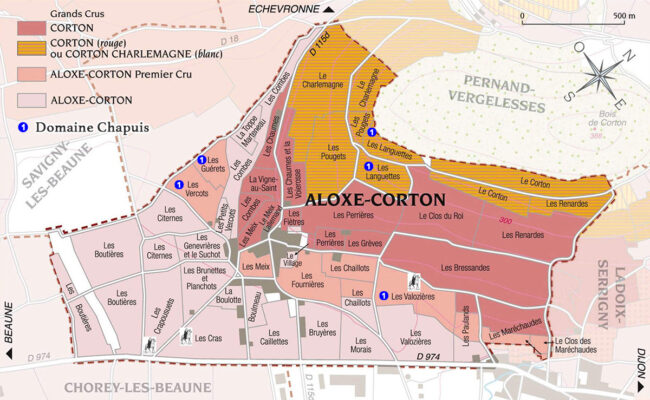
Whereas white wines from the region exist, they are rare. The deep soils are better suited for Pinot Noir; the terroir is a geological cradle for this prima donna varietal. At altitudes averaging 800 feet, the vineyards are planted in reddish earth with flint and limestone debris known locally as ‘chaillots’ mixed in, likewise rich in potassium and phosphoric acid. Such soils favor supple, highly-bred wines, while clay and marl breeds firmness and complexity. Anticipate wild berry notes that intensify with age and evolve into peony and jasmine, brandied fruits, pistachio, prune and truffle.
Domaine Chapuis
Pierre and Claire Chapuis (assisted by their parents Maurice and Anne-Marie) manage almost 30 acres of vineyards, many on the steep slopes of the Corton hillside, where over a century of winemaking knowledge resides. Capitalizing on this heritage, the domain has enlarged and modernized the winery, investing in new equipment and replanting specific plots with more suitable vines. The couple practices lutte raisonnée in an effort to keep the winemaking process as natural as possible.
“Our soil work, fertilization, our phytosanitary strategies are designed to reduce our impact on the environment so that our vines grow within a preserved biodiversity,” says Pierre. “We vinify in the traditional way and all our wines are aged in French oak—12 months for the whites and up to 18 months for the reds. We prefer a low percentage of new barrels, about 10%, which allows us to express the full potential and finesse of our terroirs.”
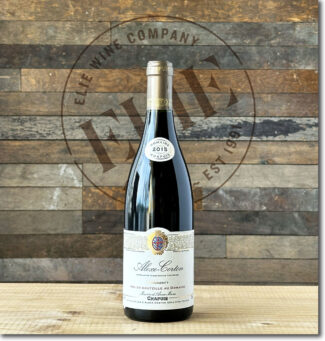 Domaine Chapuis, 2015 Aloxe-Corton ($75)
Domaine Chapuis, 2015 Aloxe-Corton ($75)
Despite the majesty of the Corton moniker, Aloxe-Corton produces a unique style of wine, due in part to amphitheater in which they grow, found elsewhere in the Côte. On the Southern side of the appellation, the dark soils are made up of limestone debris while those on the Northern side, the soils are mainly pebbly. A blend of the two, like this one, may be reminiscent of a cross between Nuits-Saint-Georges and Beaune.
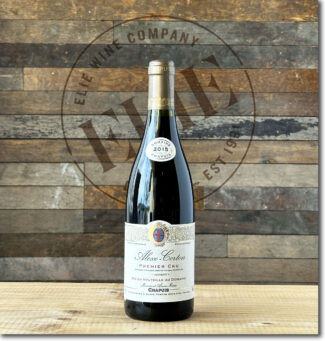 Domaine Chapuis, 2015 Aloxe-Corton Premier Cru ($96)
Domaine Chapuis, 2015 Aloxe-Corton Premier Cru ($96)
A blend of three plots where vines average 45 years old: Les Vercots, Les Guérets located in the southern part of the village and Les Valozières in the north, adjacent to the appellation Corton Les Bressandes.
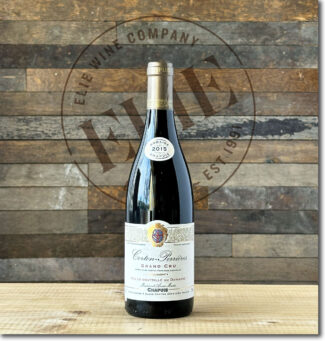 Domaine Chapuis, 2015 Corton-Perrières Grand Cru ($180)
Domaine Chapuis, 2015 Corton-Perrières Grand Cru ($180)
Lying adjacent to Les Languettes at an average altitude of nearly a thousand feet, Corton Perrières is at the northern end of Beaune, where vines mingle with stone quarries and form a unique amphitheater. The wines are known for their finesse, rather than the typically austere Corton red which show as powerful, muscular and chewy.
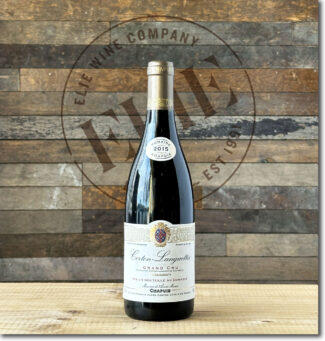 Domaine Chapuis, 2015 Corton-Languettes Grand Cru ($180)
Domaine Chapuis, 2015 Corton-Languettes Grand Cru ($180)
Les Languettes is one of five Corton climats to produce both white and red wines, primarily because here, the soils vary noticeably across 18 acres—specifically in their proportions of limestone to iron-rich marlstone. The former suits Chardonnay (which makes up the majority of plantings); the latter Pinot Noir. The property is walled and divided by a vineyard track located on the upper slopes of the Corton hill. Facing south to south-southeast at just over one thousand feet in elevation, the vineyards are just below the famous tree-line.
Savigny-lès-Beaune
Chances are, you love wines from the Rhine and are passionate about wines from the Rhône, but at first glance, ‘wines of the Rhoin’ may look like a typo. In fact, this small river flows from the cliffs of Bouilland through the commune of Savigny-lès-Beaune, and alluvia from the overflow adds fertility to the lower slopes of the hills of Beaune. With nearly nine hundred acres of vineyard, the appellation is one of Burgundy’s largest.
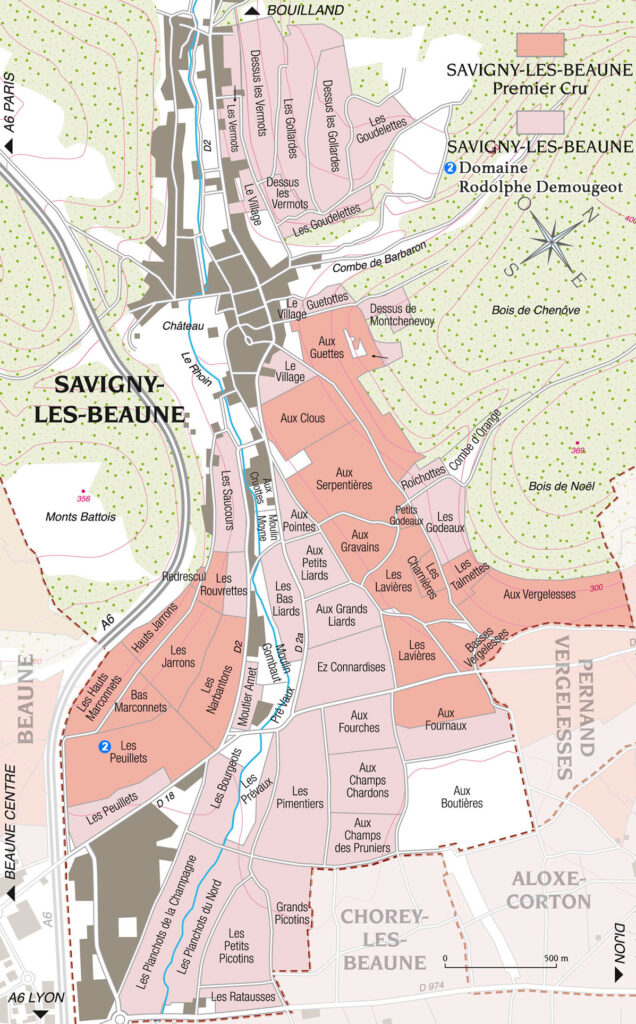
Savigny’s terroir features a gentle gradient that becomes steeper as the altitudes approach 1300 feet, where the geology is similar to that of the great Grand Cru hill of Corton. Favored exposures face the south, where the soils are gravelly and scattered with oolitic ironstone. Near the river valley, the red-brown limestone becomes more clay-rich pebble-filled while the east-facing slopes consist of sand and limestone.
Domaine Rodolphe Demougeot
When Rodolphe Demougeot created his estate in 1992, it was a tribute to his winegrower grandparents, in whose vineyards he worked as a boy and who gave him a taste for winegrowing. He began with nine acres in the Hautes-Côtes de Beaune, in Pommard and Beaune and has grown to twenty acres with plots acquired over the years in the municipalities of Savigny-les-Beaune, Monthelie and Meursault, where Rodolphe has been established since 1998.
But the move away from family tradition took some focus. He says, “I learned how to do ‘perfect’ chemical farming from them and had to deprogram both my vineyards and myself, which took a lot of time—something that evolved into a new sense of self and humility. I needed to learn to be a good farmer first, and then to improve performance in the cellar. I required an unflinching honesty about life and process.”
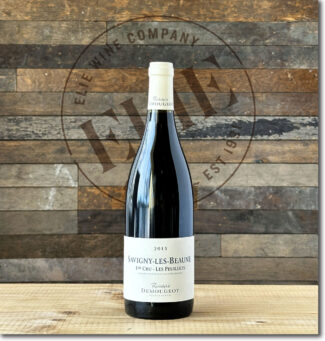 Domaine Rodolphe Demougeot, 2015 Savigny-lès-Beaune Premier Cru Les Peuillets ($95)
Domaine Rodolphe Demougeot, 2015 Savigny-lès-Beaune Premier Cru Les Peuillets ($95)
Upslope from the lieu-dit Les Bourgeots, Les Peuillets (planted in 1945) sits on a thin layer of high quality clay with limestone underneath, producing fragrant and pure wines with a delicacy that defies its concentration.
Auxey-Duresses
There was a time when the wines of Auxey-Duresses were sold under false premises—the reds were named Volnay and the whites, Meursault. In fact, experts could easily tell the difference. Yet, the differences have begun to evaporate as a new generation of winemaker in the appellation, coupled with a changing climate, has realized that Auxey-Duresses grapes may have the breeding to rival their hallowed neighbors without the need of fraud.
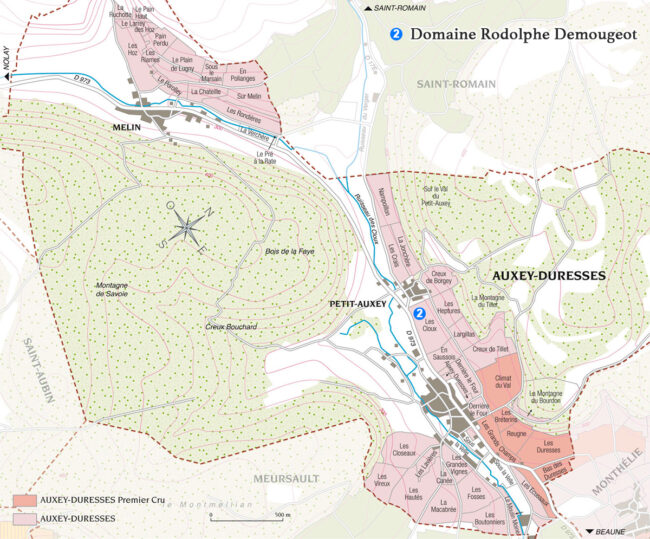
The first obstacle they had to overcome was geography. Unlike Meursault and Volnay, Auxey-Duresses vines cling to a variety of high slopes and have traditionally produced a hard red wine that is frequently sold to négociants for Bourgogne Rouge blends. But with patience, these same grapes, when bottled at estates within the appellation, improve immeasurably and become silken gems that may rival nearby powerhouses at a fraction of the cost.
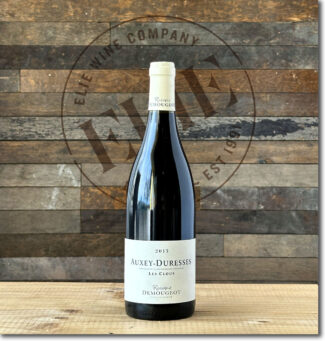 Domaine Rodolphe Demougeot, 2015 Auxey-Duresses ‘Les Clous’ ($88)
Domaine Rodolphe Demougeot, 2015 Auxey-Duresses ‘Les Clous’ ($88)
Demougeot’s parcel of Les Clous is under an acre; it enjoys direct due-south exposure, ideal for this cooler appellation. The soils are limestone and clay, very well drained due to the ample mix of small and large stones deposited by the small creek that once flowed through this valley. 100% of the grapes are destemmed and fermented on native yeasts in cement and inox vats. Once pressed, it’s settled in a tank overnight and gravity fed into 85% old French barrels.
Beaune
The historical capital of Burgundy, Beaune eponymous appellation includes 42 Premier Cru Climats producing primarily red wine (887 acres of Pinot to Chardonnay’s 143). Village-level wines can be somewhat homogeneous, although from the northern end of the commune they tend to be intense while those from the southern end are smoother and fuller.
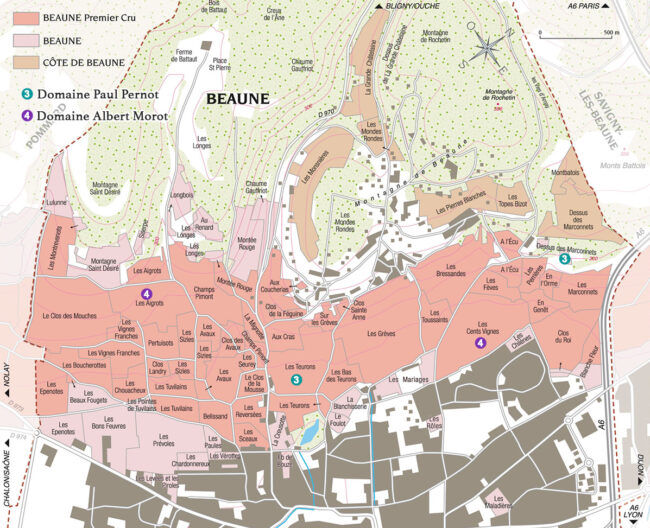
Beaune’s slopes are quite steep and the soil is thin; a breakdown of the terroir is a mouthful and a half: On the lower slopes are Argovian marls and deep soils, white, grey or yellow, tinged with red from the iron in the Oxfordian limestone. Exposures are easterly to due-south at altitudes between 700 feet and a thousand feet.
Domaine Paul Pernot
When Paul Pernot founded his domain in 1959, he centered on 25 acres of vines planted on 200-year-old family land in Puligny-Montrachet. An artisan winemaker, he developed his vineyards with great respect for the soil.
Among the top growers in Puligny, Pernod wines are celebrated for their delicacy and poise while remaining rich, ripe and with the structure to age. The property sells over 60% of its production to négociants, saving only the cream of the crop for its own bottlings. The vineyards and cellar are now managed by Paul’s two sons, Michel and Paul Jr, together with Paul Jr’s son, Philippe, and Michel’s daughter Alvina (who also as her own project). Michel heads up work in the winery, while Paul Jr and Philippe manage the vineyards while Alvina manages the administrative side. They maintain a traditional approach to winemaking with very little having changed at the domaine in the last four decades.
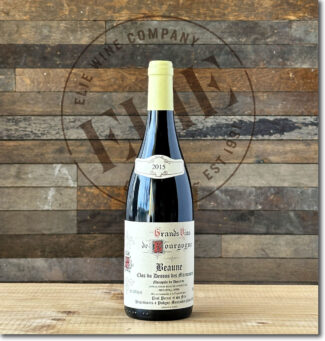 Domaine Paul Pernot, 2015 Beaune ‘Clos du Dessus des Marconnets’ Monopole ($96)
Domaine Paul Pernot, 2015 Beaune ‘Clos du Dessus des Marconnets’ Monopole ($96)
The name of this east-facing, entirely-walled vineyard refers to a German tribe called the Marcomans who once settled near the nine-acre plot. The Chardonnays are situated at the top of the hill where it is windy, and grow in a marl and sandy soil, while the Pinot Noirs are situated mid-slope where they are exposed to more sun. As in most such Burgundian expositions, soil erosion at the top of the plot produces stonier terroirs as it grows more alluvial toward the bottom. The monopole (owned entirely by the family) was planted by Paul between 1957 and 1961 and pre-dates modern clones.
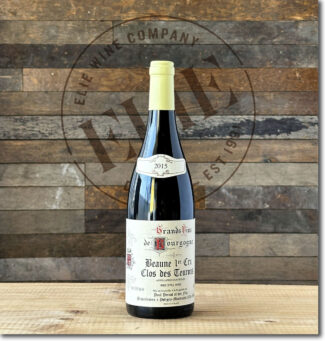 Domaine Paul Pernot, 2015 Beaune Premier Cru Clos des Teurons ($110)
Domaine Paul Pernot, 2015 Beaune Premier Cru Clos des Teurons ($110)
Sun-drenched des Teurons is one of the more highly acclaimed climats in Beaune; it sits high on the slope facing east, and its limestone-rich terroir produces grapes that ripen early and wines that age beautifully.
Domaine Albert Morot
Established by Albert Morot in 1820, Domaine Albert Morot is considered one of the leading properties in the Côte de Beaune. The estate consists of about 20 acres of vineyards, almost entirely in the Beaune Premiers Crus of Les Teurons, Les Gréves, Les Toussaints, Les Bressandes, Les Cent Vignes, Les Marconnets, and La Bataillére.
Geoffrey Choppin de Janvry has been responsible for the wines since 2000, when his aunt Françoise Choppin (great-granddaughter of Albert Morot) retired. While retaining the deep focus on quality started by his aunt in the 1980s, including green harvesting, double sorting during harvesting, and minimizing cellar interventions, Geoffroy has ushered the estate into a new era by gradually implementing organic farming methods.
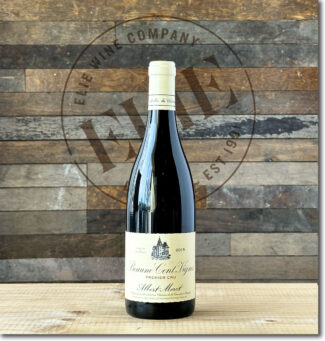 Domaine Albert Morot, 2015 Beaune Premier Cru Cent-Vignes ($110)
Domaine Albert Morot, 2015 Beaune Premier Cru Cent-Vignes ($110)
The three acre plot of “Les Cent Vignes” (one hundred vines) is located at the bottom of the slope with a southeastern exposure and is composed mainly of loam and clay soils. The vines on this plot were planted in 1958 and are known for producing wines that are remarkable for their color and delicacy of aromas. On the palate the wines combine complexity and mellowness.
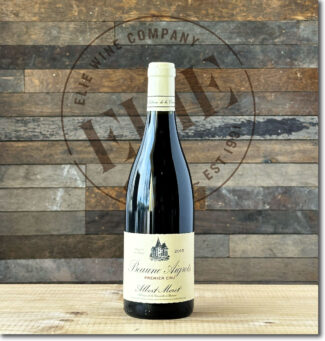 Domaine Albert Morot, 2015 Beaune Premier Cru Aigrots Rouge ($110)
Domaine Albert Morot, 2015 Beaune Premier Cru Aigrots Rouge ($110)
Located next to the celebrated Clos des Mouches vineyard on the middle of the slope, Les Aigrots faces east. The stony soil of this two acre plot is rich in loam and clay, producing full-bodied, generous wines. The vines are between 29 and 37 years old.
Pommard
If Burgundy is a volume of poetry, Pommard might be considered its Alfred, Lord Tennyson, offering power and rich structure, a charge of the Light Brigade, only with a substantially safer outcome. Pommard is the beginning of serious Pinot Noir in Burgundy; nothing else is grown and nothing else allowed besides (perhaps inexplicably) a few vineyards of the Lemberger/ Sankt-Laurent cross ‘André.’ Aptly named for Pomona, the Roman god of fruit trees, Pommard’s most muscular wines hail from its mid-slope Premier Cru vineyards which run in a nearly uninterrupted from the commune boundaries of Beaune in the north to Volnay in the south. Even that may belie the quality of these wines; most experts believe that the Les Épenots and Les Rugiens Premier Crus should be promoted to join Corton in its Grand Cru status. Once in line for this prestigious upgrade, the vignerons of the time were wary of the restrictive Grand Cru production laws and declined the offer.
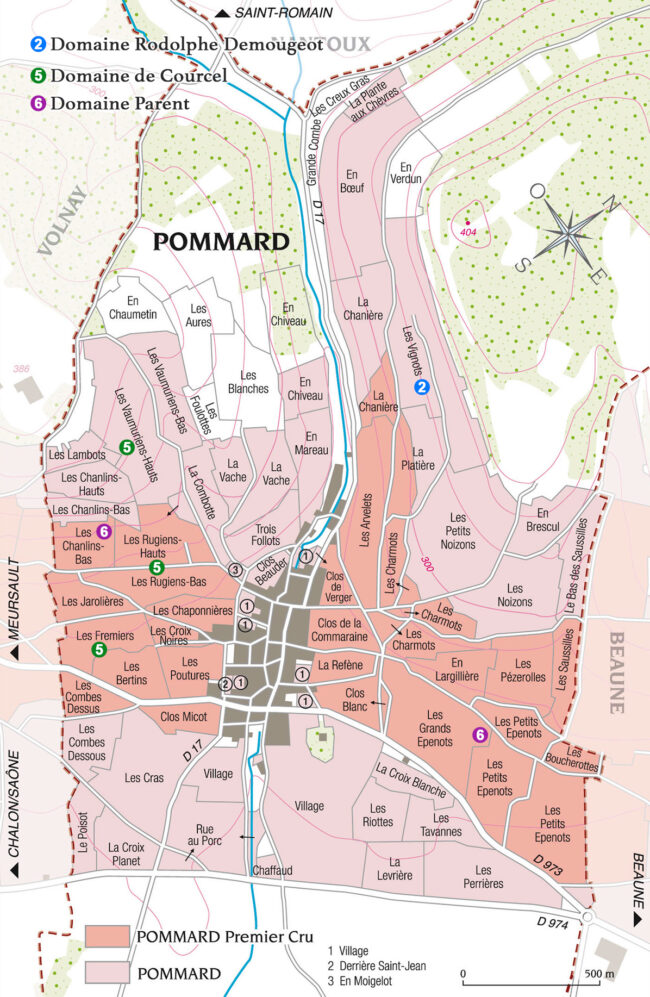
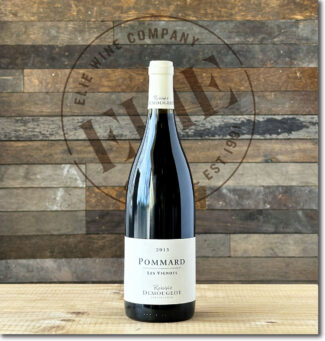 Domaine Rodolphe Demougeot, 2015 Pommard Les Vignots ($120)
Domaine Rodolphe Demougeot, 2015 Pommard Les Vignots ($120)
Les Vignots is a lieu-dit situated on the upper slope of the combe behind the village of Pommard; it faces south, giving the wines typical Pommard power while its elevation (over a thousand feet) lends high-toned aromas and finesse—especially, a racy mineral edge. The average vine age (fifty years) also lends to the wine’s remarkable concentration.
Domaine de Courcel
“Too often winemakers make a style, not a wine,” says Gilles de Courcel, “which is what many négociants do when they blend wines they buy from different estates.”
For the past four hundred years, the de Courcel family has produced award-winning Pommards from some of the region’s most renowned vineyards. Its reputation is all the more remarkable, considering that the domain never produces more than 30,000 bottles per year.
Essentially built around Premier Cru sites, de Courcel’s 26 acres are peppered across Le Grand Clos des Épenots, Les Rugiens, Les Frémiers and Les Croix Noires. Le Grand Clos des Épenots, which accounts for 50% of the Domaine’s production, and Les Rugiens are in a climat class of their own. The estate is currently managed by Gilles de Courcel, Anne Bommelaer and Marie de Courcel.
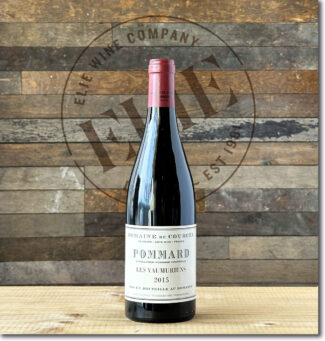 Domaine de Courcel, 2015 Pommard ‘Les Vaumuriens’ ($130)
Domaine de Courcel, 2015 Pommard ‘Les Vaumuriens’ ($130)
Vaumuriens is a Village-level appellation located just above Rugiens where soils are white with limestone and fairly thin; with vines around 40 years old, the four-acre vineyard produces spicy wines with aromas leaning towards cassis, but with a slight tropical edge.
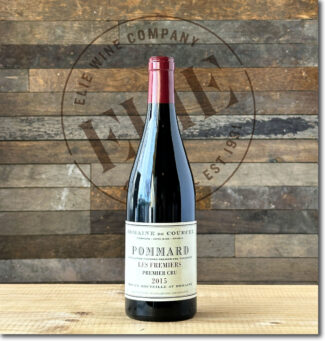 Domaine de Courcel, 2015 Pommard Premier Cru Les Fremiers ($190)
Domaine de Courcel, 2015 Pommard Premier Cru Les Fremiers ($190)
Frémiers is a two-acre climat located south of Pommard, right below Rugiens, at the base of the slope. The red and brown topsoil is rich in both clay and limestone and is deeper than that of the Rugiens; the resulting wines are elegant and sophisticated with fine-grained tannins and pie-spice aromatics.
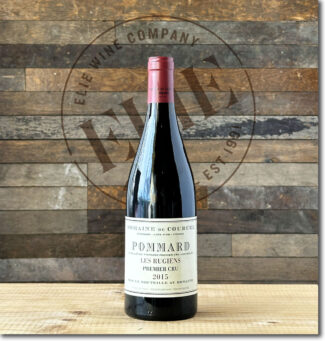 Domaine de Courcel, 2015 Pommard Premier Cru Les Rugiens ($320)
Domaine de Courcel, 2015 Pommard Premier Cru Les Rugiens ($320)
Les Rugiens consists of two parcels, Les Rugiens Haut and Les Rugiens Bas, based on their respectively higher and lower positions near the summit of the Pommard slope. The name comes from the French word ‘rouge’ and refers to the reddish soil in the vineyard, a result of high iron content. As such, these wines tend to be among the most rugged in Pommard and are generally best if cellared for a minimum of ten years.
Domaine Parent
A lawyer by training, meticulous winemaker Anne Parent is the matriarch of Pommard. Passionate not only about her wines but about the role of female vignerons in Burgundy, she founded the Women’s Winemaker Association in Burgundy and was its first president. Along with her sister, Catherine, she took over the Parent estate in 1998, becoming the 12th generation of winemakers in the family.
Parent is one of the great names in Pommard. The 25+ acre domaine boasts some of the finest parcels in the appellation, as well as holdings in Corton, Beaune, Ladoix, and Monthélie. Recent vintages have seen the domaine firing on all cylinders as they have moved towards an organic (certified 2013) and biodynamic approach to viticulture. Anne believes that these techniques help the soil regain its energy, and subsequently produce the most balanced fruit possible. Her aim is to make, “wines with character and personality, but also subtle, complex and sensual,” while maintaining the health of the environment and the people that work the vines.
Anne Parent calls 2015, “A very yum-yum vintage!”
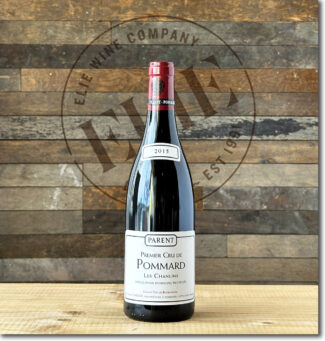 Domaine Parent, 2015 Pommard Premier Cru Les Chanlins ($150)
Domaine Parent, 2015 Pommard Premier Cru Les Chanlins ($150)
Les Chanlins is an 80-year-old climat with an ideal location abutting Volnay Premier Cru Les Pitures and Pommard Premier Cru Les Rugiens Haut. Here, limestone-heavy soils combine Pommard’s power with Volnay’s trademark elegance to make Pinot Noir with a sublime combination of grace and intensity. Parent’s is vinified with 5% whole clusters and was matured in 50% new oak.
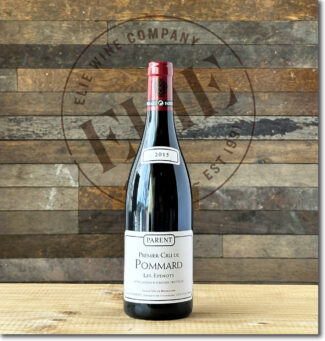 Domaine Parent, 2015 Pommard Premier Cru Les Epenots ($180)
Domaine Parent, 2015 Pommard Premier Cru Les Epenots ($180)
Pommard has no Grand Crus; Épenots—which may be worthy of the status—is one of two parcels under the name Les Épenots (Grand and Petit) situated in the north of the commune on 62 acres of clay and calcareous soil. The word Épenots comes from the French épine, referring to the spiny bushes that once surrounded the vineyard. Parent’s wine is a blend of Grands and Petits Épenots, with half whole bunch and half new wood.
Santenay
Jean-Marc Vincent, president of the Santenay producers association, maintains that the appellation has gotten an undeserved bad rap. It’s a stereotype, he believes, that might be rooted in the fact that Santenay has no Grand Cru vineyards: “And yet, so far in the 21st century, Santenay has produced more than 50 wines rated 90 points or higher in ‘Wine Spectator‘ blind tastings, with retail prices from $30 to well below three figures for our top Crus.”
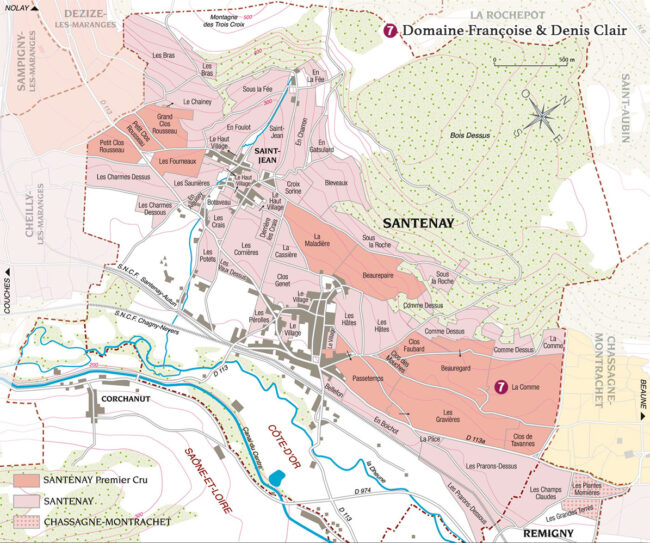
Santenay soils contain less limestone than many of its northerly neighbors, and more marlstone, although proportions vary based on where the vineyard is located—grey limestone can be found up to a height of 1700 feet, while at a thousand feet, oolitic limestone lies over a layer of marl. The ideal exposure for these vineyards is east to southeast.
Although the wines are often referred to as ‘rustic’ rather than ‘elegant’, this is not to say that the wines of Santenay do not capture the poetry of Pinot Noir; Santenay has the soul of Volnay and the body of Pommard. To those who love such earthy, complex Burgundies, Santenay is a marvelously affordable discovery.
Domaine Françoise & Denis Clair
Domaine Françoise & Denis Clair was created in 1986 when Denis set out to bottle his own wine – The Clair family had owned parcels in the Santenay area for generations but sold most of their production to négociants. Initially stretching over only 12 acres of Pinot Noir, today the domaine has expanded to 37 acres, mainly with the acquisition of Chardonnay plots from the best terroirs in Saint-Aubin, where Françoise was born and where the winery is located.
Denis built the domaine’s reputation through seductive red wines. Their son, Jean-Baptiste Clair, joined the family business in 2000 and quickly elevated the production of white wines to the highest levels of quality. The domaine takes great effort to work as organically as possible. The fruit is hand-picked and the wines are fermented by indigenous yeasts. Sulfite addition is minimal. Like most winemakers at the highest level, the aim is to produce wines that speak of the land from which they arise.
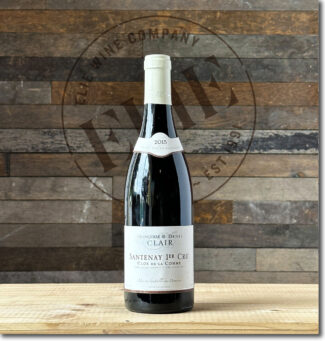 Domaine Françoise & Denis Clair, 2015 Santenay Premier Cru Clos de la Comme ($79)
Domaine Françoise & Denis Clair, 2015 Santenay Premier Cru Clos de la Comme ($79)
The best vineyards of Santenay come from the northern end of the appellation, where they border those of Chassagne-Montrachet. Here, the increased proportion of gravel, marl and limestone in the soil adds structure and richness to the grapes, which in turn produce a more powerful wine. Premier Cru ‘La Comme’ faces southeast, allowing grapes that reach full maturity even in cooler vintages and powerhouse reds in warmer ones. The name is the regional form of Combe, because the vineyard is in the extension of the Combe of Saint-Aubin.
Notebook …
Making Sense Of Burgundy: What Makes It So Singular
Above all, terroir is an ideology; a flight of vinous fancy that insists a wine’s taste and aroma reflect its place of origin. This reflection may be subtle or overt, but there’s plenty of science behind it. Terroir includes specific soil types, topography, microclimate, landscape characteristics and biodiversity—all features that interact with a winemaker’s choice of viticultural and enological techniques.
Nowhere is this more in evidence than Burgundy, where the notion of place-identity is sacrosanct. The central role that terroir plays in every hierarchal level is not only part of the culture, but it is based on centuries’ worth of confirmation. Although in loose geological terms the entire appellation sits on an ancient limestone seabed, this unity is shattered into an immense mosaic of thousands of individual ‘climats’ from which the vine draws color and flavor. Some are ludicrously tiny—renowned Romanée, for example, is under five acres—and the secret alchemy of terroir may be diversified throughout a village, a vineyard, and even in vine rows within that vineyard.
Burgundian labels reflect that; the quality-focused grades with which we have become so familiar—Bourgogne, Village, Premier Cru and Grand Cru—each have individual sets of rules regarding yield, grapes and production methods that winemakers are legally required to follow. From there, we may or may not find the name of a climat, a term used interchangeably with lieu-dit. Although the Grand Cru wines are generally considered to be classified on the vineyard-plot level and defined as separate AOPs (with the exception of Chablis Grand Cru), some Grand Crus are in fact divided into several lieux-dits. Echézeaux, for example, includes 10, one of which has two alternative names: Les Cruots is also known as Vignes Blanches. Although it is illegal to use the name of lieux-dits on Grand Cru labels, the law is flouted in Clos de Vougeot and one or two other Grand Crus to consumer-friendly ends.
The Value Of Burgundy, Regardless Of The Price
Burgundy ‘the concept’ has always hovered in the empyrean—even if the best of the physical stuff drifted out of most rational price ranges. More than stately, austere Bordeaux, more than hedonistic Rhône, more than transcendent Champagne, more than ethereal Loire, Burgundy represents beauty and power recombinant; the Athena of wine.
Its value in the perception outstrips its value on the palate; whereas wine prices are set on reputation of terroirs, the poetry of our mental landscapes remains beyond our ability to quantify. It can only be considered by sense, not cents.
In the retail business, we’re charged with vigilance to ensure that the prices we charge is balanced by the products we sell and few places present more of a challenge than Burgundy, the most coveted wine on the planet. The changing climate may have brought more fine Burgundy appellations to market, but there are fewer of the wines themselves—yields are often a trade-off when vineyards are increasingly dry and hot throughout the season and erratic weather produces more and more crop-devastating storms. Prices have risen so sharply that sticker-shock is an inevitable part of Burgundy shopping and the shelf-dressing domains have priced themselves virtually beyond reach.
Still, although the concept of value may be on a sliding scale in Burgundy, relative bargains abound. And in any case, we can ascend straight up the hierarchy, from village wines to Premier Crus to the highly-rarefied domains of the Grand Cru, nothing will ever quite approach the finesse that Burgundy plays on the imagination.
- - -
Posted on 2024.05.01 in Aloxe-Corton, Auxey-Duresses, Santenay, Côte de Beaune, Pommard, Beaune, Côte de Beaune, Savigny-lès-Beaune, France, Burgundy, Wine-Aid Packages
Featured Wines
- Notebook: A’Boudt Town
- Saturday Sips Wines
- Saturday Sips Review Club
- The Champagne Society
- Wine-Aid Packages
Wine Regions
Grape Varieties
Albarino, Albarín Blanco, Albarín Tinto, Albillo, Aleatico, Aligote, Arbanne, Aubun, Barbarossa, barbera, Biancu Gentile, bourboulenc, Cabernet Franc, Caino, Caladoc, Calvi, Carcajolu-Neru, Carignan, Chablis, Chardonnay, Chasselas, Cinsault, Clairette, Corvina, Counoise, Dolcetto, Erbamat, Ferrol, Frappato, Friulano, Fromenteau, Gamay, Garnacha, Garnacha Tintorera, Gewurztraminer, Graciano, Grenache, Grenache Blanc, Groppello, Juan Garcia, Lambrusco, Loureira, Macabeo, Macabou, Malbec, Malvasia, Malvasia Nera, Marcelan, Marsanne, Marselan, Marzemino, Mondeuse, Montanaccia, Montònega, Morescola, Morescono, Moscatell, Muscat, Natural, Niellucciu, Parellada, Patrimonio, Pedro Ximénez, Petit Meslier, Petit Verdot, Pineau d'Aunis, Pinot Blanc, Pinot Gris, Pinot Meunier, Pinot Noir, Pouilly Fuisse, Pouilly Loche, Poulsard, Prieto Picudo, Riesling, Rondinella, Rose, Rousanne, Roussanne, Sagrantino, Sauvignon Blanc, Savignin, Sciacarellu, Semillon, Souson, Sparkling, Sumoll, Sylvaner, Syrah, Tannat, Tempranillo, Trebbiano, Trebbiano Valtenesi, Treixadura, Trousseau, Ugni Blanc, vaccarèse, Verdicchio, Vermentino, Xarel-loWines & Events by Date
- July 2024
- June 2024
- May 2024
- April 2024
- March 2024
- February 2024
- January 2024
- December 2023
- November 2023
- October 2023
- September 2023
- August 2023
- July 2023
- June 2023
- May 2023
- April 2023
- March 2023
- February 2023
- January 2023
- December 2022
- November 2022
- October 2022
- September 2022
- August 2022
- July 2022
- June 2022
- May 2022
- April 2022
- March 2022
- February 2022
- January 2022
- December 2021
- November 2021
- October 2021
- September 2021
- August 2021
- July 2021
- June 2021
- May 2021
- April 2021
- March 2021
- February 2021
- January 2021
- December 2020
- November 2020
- October 2020
- September 2020
- August 2020
- July 2020
- June 2020
- May 2020
- April 2020
- March 2020
- February 2020
- January 2020
- December 2019
- November 2019
- October 2019
- September 2019
- August 2019
- July 2019
- June 2019
- May 2019
- April 2019
- March 2019
- February 2019
- January 2019
- December 2018
- November 2018
- October 2018
- September 2018
- August 2018
- July 2018
- June 2018
- May 2018
- April 2018
- March 2018
- February 2018
- January 2018
- December 2017
- November 2017
- October 2017
- September 2017
- August 2017
- July 2017
- June 2017
- May 2017
- April 2017
- March 2017
- February 2017
- January 2017
- December 2016
- November 2016
- October 2016
- September 2016
- August 2016
- July 2016
- June 2016
- May 2016
- April 2016
- March 2016
- February 2016
- January 2016
- December 2015
- November 2015
- October 2015
- September 2015
- August 2015
- July 2015
- June 2015
- May 2015
- April 2015
- March 2015
- February 2015
- January 2015
- December 2014
- November 2014
- October 2014
- September 2014
- August 2014
- July 2014
- June 2014
- April 2014
- March 2014
- February 2014
- January 2014
- December 2013
- November 2013
- October 2013
- September 2013
- August 2013
- July 2013
- June 2013
- May 2013
- April 2013
- March 2013
- February 2013
- January 2013
- December 2012
- November 2012
- October 2012
Search



